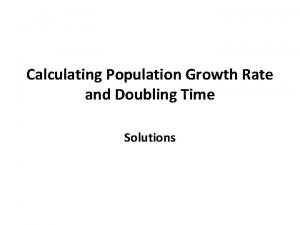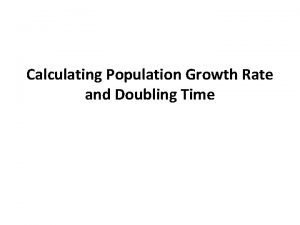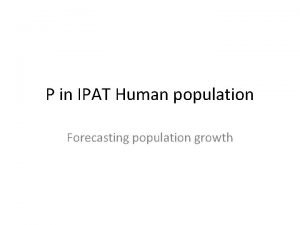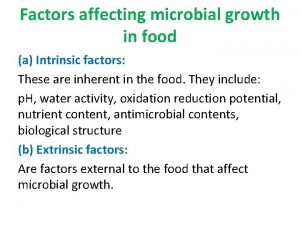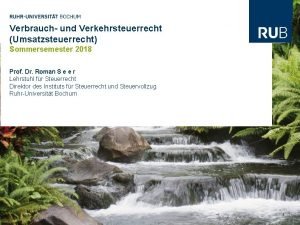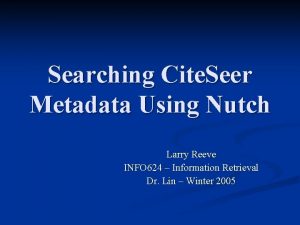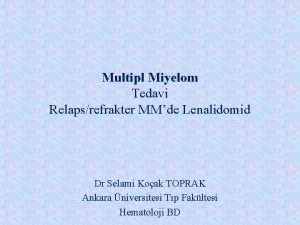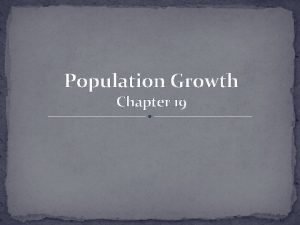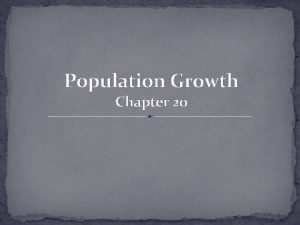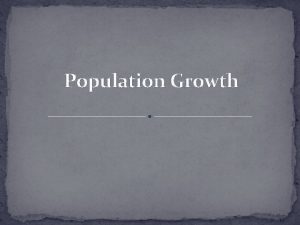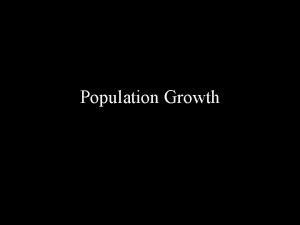Intrinsic Rate of Seer Fish Population Growth r

















- Slides: 17

Intrinsic Rate of Seer Fish Population Growth (r) Practical Workshop on Stock Assessments of Indo – Pacific King Mackerel and Narrow Barred Spanish Mackerel in the Southeast Asian Waters 16 – 20 July 2018 SEAFDEC/TD, Thailand

Presentation Outline • What is “r” • Method • r for Seer Fishes Species • Fishing Ground • Narrow – Barred Spanish Mackerel • Indo – Pacific King Mackerel • Summary and discussion

What is “r” • Intrinsic rate of population growth or intrinsic rate of increasing (r) • The proportion represented to average growth rate of entire population which was used to measured the potential for growth rate in the population • This is the fundamental metric in the ecology and evolution of immediate practical application in wild life conservation and management (Cortés, 2016) • Based on species life history concept or r and K species Characteristics r – species K – species Maturity Early age and small size matured Late age and large size matured Off springs Large number without parental care Small number with parental care Life spam Short life spam Long life spam

What is “r” • This parameter is used in several ecological study to monitoring the changing of population size • For ecological study, r was commonly estimated demographic parameters used for assessment of extinction risk as well (Pardo et al. , 2016) • Useful for the endangered species study, population management and fishery resource population (sharks, tunas and other important economical species)

Method • Relation between r, carrying capacity (K) and MSY for ASPIC When And r = MSY = K = Intrinsic rate of increasing Maximum Sustainable Yield Carrying capacity

“r” for Seer Fishes Species • FAO: Technical paper (definition and concept of r) • IOTC: Scientific report and papers • Fishbase: In species page, the last topic named “Estimates of some properties based on models” • Others

Fishing Ground

Narrow – Barred Spanish Mackerel • Scomberomorus commerson (Lacepède, 1800) • Pelagic, long shore migratory species • Small school, feed on small pelagic fishes, squids and Peneoid shrimps • Lm 85 cm. • L max 240 cm. FL, normally 120 cm. • IUCN status: Near Threatened

Narrow – Barred Spanish Mackerel • Scomberomorus commerson (Lacepède, 1800) S. commerson A 57 160000 A 71 140000 Catch (MT) 120000 100000 80000 60000 40000 20000 0 2008 2009 2010 2011 Year 2012 2013 2014

Narrow – Barred Spanish Mackerel • Scomberomorus commerson (Lacepède, 1800) r Area References 0. 54 (0. 27 – 1. 09) Worldwide Fishbase 0. 31 Western Australia Mackie (2013) 0. 6 – 1. 5 Indian Ocean IOTC (2015) 1. 0 – 1. 5 Indian Ocean IOTC (2016)

Indo – Pacific King Mackerel • Scomberomorus guttatus (Bloch & Schneider, 1801) • Pelagic, migratory species along shore line, sometimes enter estuarine • Small school, feed on small pelagic fishes, squids and crustaceans • Lm 40 cm. • L max 76 cm FL. , normally 55 cm. • IUCN status: Data Deficient

Indo – Pacific King Mackerel • Scomberomorus guttatus (Bloch & Schneider, 1801) S. guttatus 30000 A 57 A 71 25000 Catch (MT) 20000 15000 10000 5000 0 2008 2009 2010 2011 Year 2012 2013 2014

Indo – Pacific King Mackerel • Scomberomorus guttatus (Bloch & Schneider, 1801) r Area References 1. 0 – 1. 5 Indian Ocean IOTC (2016)

Summary and Discussion • Intrinsic rate of population growth or intrinsic rate of increasing (r) • Useful for monitoring the changing in population size of many fishery resources • Important seeding value for ASPIC • To review r value, many reference sources provide r value including FAO, IOTC and fishbase

Summary and Discussion • For calculation, r should be calculated specifically for each stock by species • For literature review, the references for r should be selected carefully considering to fishing ground/distribution area • The most update information from appropriate FG or area should be considered to avoid any uncertainties

THANK YOU SO MUCH FOR YOUR KIND ATTENTION!!!

• Cortes, E. , 2016, Perspective on the intrinsic rate of population increasing, Methods in Ecology and Evolution, vol. 7(10). • Pardo, S. A. , H. K. Kindsvater, J. D. Raynolds and N. K. Dulvy, 2016, Maximum intrinsic rate of population increase in sharks, rays and chimeras: the importance of survival to maturity, Canadian Journal of Fisheries and Aquatic Sciences, vol. 73(8), pp. 1159 – 1163.
 One fish two fish red fish blue fish ride
One fish two fish red fish blue fish ride Plant growth analysis
Plant growth analysis Twofish and blowfish
Twofish and blowfish Interoparous
Interoparous Birth rate decline
Birth rate decline Doubling time calculator
Doubling time calculator Rule of 70 in population growth
Rule of 70 in population growth Percent change formula
Percent change formula Intrinsic factors for microbial growth
Intrinsic factors for microbial growth Ieer vs eer
Ieer vs eer Ieer vs seer
Ieer vs seer Roman seer
Roman seer Takayuki todo
Takayuki todo Larry reeve
Larry reeve Harmony in human being
Harmony in human being Seer doer and enjoyer
Seer doer and enjoyer Seer kidney cancer
Seer kidney cancer Seer coop
Seer coop





